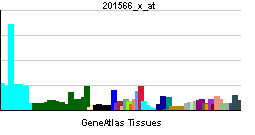ID2
| Inhibitor of DNA binding 2, dominant negative helix-loop-helix protein | |||||||||||
|---|---|---|---|---|---|---|---|---|---|---|---|
| Identifiers | |||||||||||
| Symbols | ID2 ; GIG8; ID2A; ID2H; MGC26389 | ||||||||||
| External IDs | Template:OMIM5 Template:MGI HomoloGene: 1632 | ||||||||||
| |||||||||||
| RNA expression pattern | |||||||||||
 | |||||||||||
 | |||||||||||
| More reference expression data | |||||||||||
| Orthologs | |||||||||||
| Template:GNF Ortholog box | |||||||||||
| Species | Human | Mouse | |||||||||
| Entrez | n/a | n/a | |||||||||
| Ensembl | n/a | n/a | |||||||||
| UniProt | n/a | n/a | |||||||||
| RefSeq (mRNA) | n/a | n/a | |||||||||
| RefSeq (protein) | n/a | n/a | |||||||||
| Location (UCSC) | n/a | n/a | |||||||||
| PubMed search | n/a | n/a | |||||||||
Inhibitor of DNA binding 2, dominant negative helix-loop-helix protein, also known as ID2, is a human gene.
The protein encoded by this gene belongs to the inhibitor of DNA binding (ID) family, members of which are transcriptional regulators that contain a helix-loop-helix (HLH) domain but not a basic domain. Members of the ID family inhibit the functions of basic helix-loop-helix transcription factors in a dominant-negative manner by suppressing their heterodimerization partners through the HLH domains. This protein may play a role in negatively regulating cell differentiation. A pseudogene has been identified for this gene.[1]
References
Further reading
- Biggs J, Murphy EV, Israel MA (1992). "A human Id-like helix-loop-helix protein expressed during early development". Proc. Natl. Acad. Sci. U.S.A. 89 (4): 1512–6. PMID 1741406.
- Iavarone A, Garg P, Lasorella A; et al. (1994). "The helix-loop-helix protein Id-2 enhances cell proliferation and binds to the retinoblastoma protein". Genes Dev. 8 (11): 1270–84. PMID 7926730.
- Maruyama K, Sugano S (1994). "Oligo-capping: a simple method to replace the cap structure of eukaryotic mRNAs with oligoribonucleotides". Gene. 138 (1–2): 171–4. PMID 8125298.
- Kurabayashi M, Jeyaseelan R, Kedes L (1993). "Two distinct cDNA sequences encoding the human helix-loop-helix protein Id2". Gene. 133 (2): 305–6. PMID 8224921.
- Hara E, Yamaguchi T, Nojima H; et al. (1994). "Id-related genes encoding helix-loop-helix proteins are required for G1 progression and are repressed in senescent human fibroblasts". J. Biol. Chem. 269 (3): 2139–45. PMID 8294468.
- Mathew S, Chen W, Murty VV; et al. (1996). "Chromosomal assignment of human ID1 and ID2 genes". Genomics. 30 (2): 385–7. doi:10.1006/geno.1995.0037. PMID 8586447.
- Lasorella A, Iavarone A, Israel MA (1996). "Id2 specifically alters regulation of the cell cycle by tumor suppressor proteins". Mol. Cell. Biol. 16 (6): 2570–8. PMID 8649364.
- Hara E, Hall M, Peters G (1997). "Cdk2-dependent phosphorylation of Id2 modulates activity of E2A-related transcription factors". EMBO J. 16 (2): 332–42. doi:10.1093/emboj/16.2.332. PMID 9029153.
- Langlands K, Yin X, Anand G, Prochownik EV (1997). "Differential interactions of Id proteins with basic-helix-loop-helix transcription factors". J. Biol. Chem. 272 (32): 19785–93. PMID 9242638.
- Suzuki Y, Yoshitomo-Nakagawa K, Maruyama K; et al. (1997). "Construction and characterization of a full length-enriched and a 5'-end-enriched cDNA library". Gene. 200 (1–2): 149–56. PMID 9373149.
- Yates PR, Atherton GT, Deed RW; et al. (1999). "Id helix-loop-helix proteins inhibit nucleoprotein complex formation by the TCF ETS-domain transcription factors". EMBO J. 18 (4): 968–76. doi:10.1093/emboj/18.4.968. PMID 10022839.
- Yokota Y, Mansouri A, Mori S; et al. (1999). "Development of peripheral lymphoid organs and natural killer cells depends on the helix-loop-helix inhibitor Id2". Nature. 397 (6721): 702–6. doi:10.1038/17812. PMID 10067894.
- Law SF, Zhang YZ, Fashena SJ; et al. (1999). "Dimerization of the docking/adaptor protein HEF1 via a carboxy-terminal helix-loop-helix domain". Exp. Cell Res. 252 (1): 224–35. doi:10.1006/excr.1999.4609. PMID 10502414.
- Moldes M, Boizard M, Liepvre XL; et al. (2000). "Functional antagonism between inhibitor of DNA binding (Id) and adipocyte determination and differentiation factor 1/sterol regulatory element-binding protein-1c (ADD1/SREBP-1c) trans-factors for the regulation of fatty acid synthase promoter in adipocytes". Biochem. J. 344 Pt 3: 873–80. PMID 10585876.
- Liu J, Shi W, Warburton D (2000). "A cysteine residue in the helix-loop-helix domain of Id2 is critical for homodimerization and function". Biochem. Biophys. Res. Commun. 273 (3): 1042–7. doi:10.1006/bbrc.2000.3055. PMID 10891368.
- Lasorella A, Noseda M, Beyna M; et al. (2000). "Id2 is a retinoblastoma protein target and mediates signalling by Myc oncoproteins". Nature. 407 (6804): 592–8. doi:10.1038/35036504. PMID 11034201.
- Roberts EC, Deed RW, Inoue T; et al. (2001). "Id helix-loop-helix proteins antagonize pax transcription factor activity by inhibiting DNA binding". Mol. Cell. Biol. 21 (2): 524–33. doi:10.1128/MCB.21.2.524-533.2001. PMID 11134340.
- Wang S, Sdrulla A, Johnson JE; et al. (2001). "A role for the helix-loop-helix protein Id2 in the control of oligodendrocyte development". Neuron. 29 (3): 603–14. PMID 11301021.
- Wong J, Funes-Duran M, Ahlberg J; et al. (2001). "Characterization of a basic helix-loop-helix protein, ABF-1: nuclear localization, transcriptional properties, and interaction with Id-2". DNA Cell Biol. 20 (8): 465–71. doi:10.1089/104454901316976091. PMID 11560778.
- Suzuki H, Fukunishi Y, Kagawa I; et al. (2001). "Protein-protein interaction panel using mouse full-length cDNAs". Genome Res. 11 (10): 1758–65. doi:10.1101/gr.180101. PMID 11591653.
| This protein-related article is a stub. You can help Wikipedia by expanding it. |